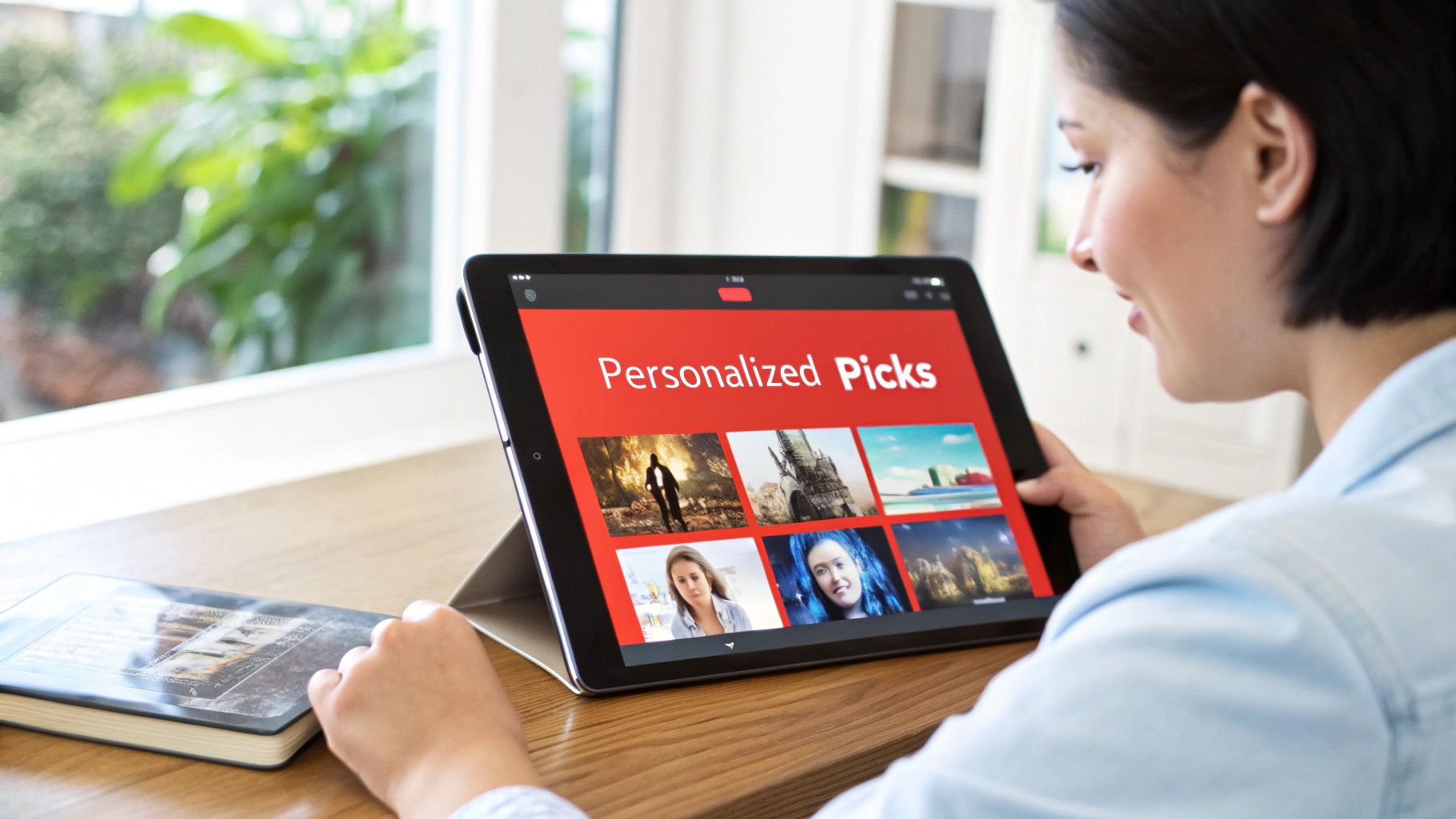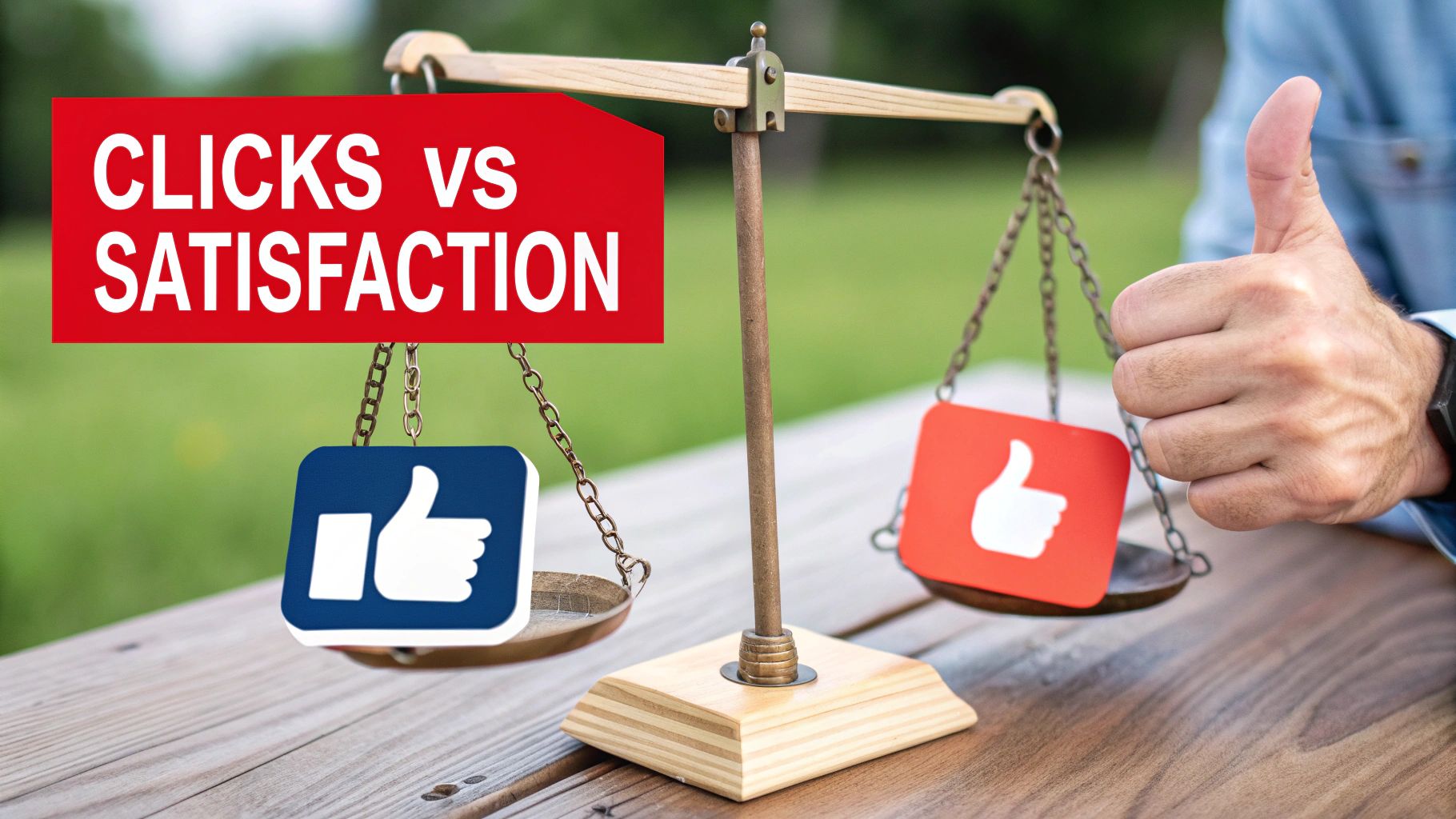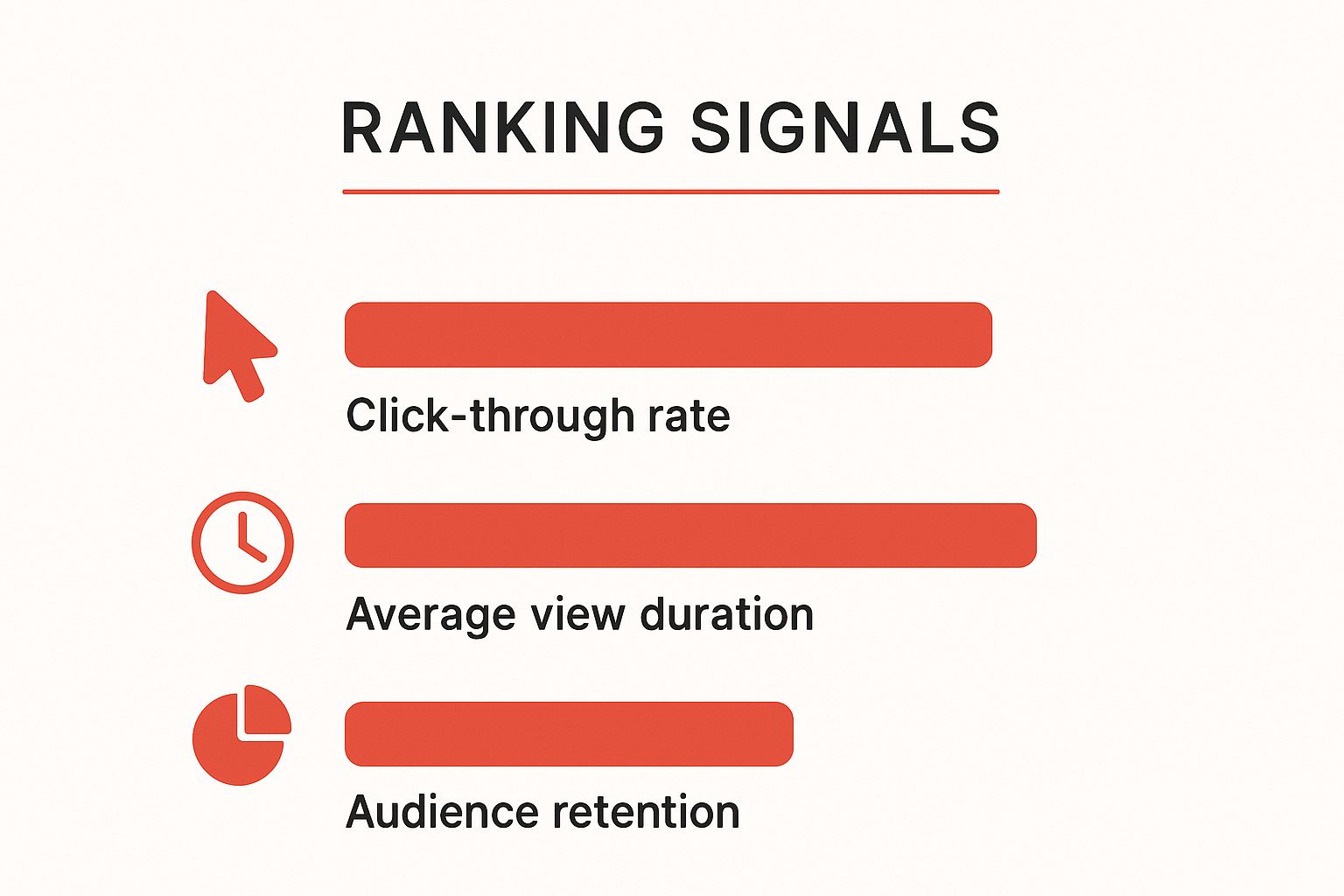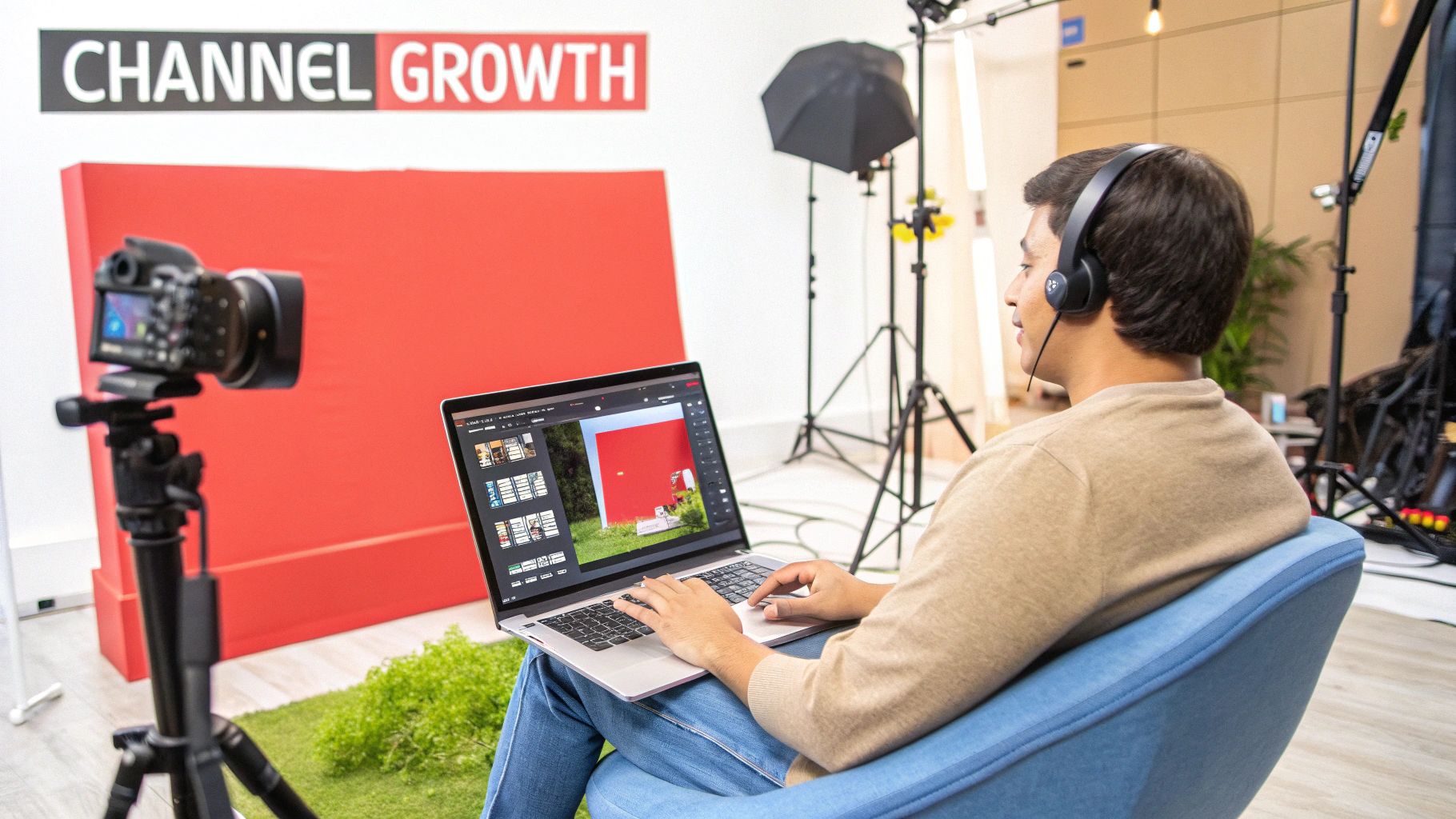At its heart, the YouTube algorithm is a sophisticated recommendation system. Its job is to find the perfect video for each person at any given moment. It isn’t one single, all-powerful program but a collection of systems working together. These systems have two simple goals: match viewers with videos they’ll love and keep them on the platform longer.
What Is the YouTube Algorithm

It’s helpful to think of the YouTube algorithm less like a strict gatekeeper and more like a personal TV guide. It doesn't just push what’s popular; it learns your tastes and viewing habits to build a custom-made experience just for you. This is a crucial distinction every creator needs to grasp: the algorithm’s main job is to serve the viewer, not the creator.
This system is constantly crunching billions of data points. It doesn't "watch" your video to see if it’s good. Instead, it watches how people react to your video. Every like, share, comment, and second of watch time is a signal. Success, for the algorithm, is measured by how happy viewers are and how long they stick around.
The Two Core Goals of the Algorithm
To really get how the YouTube algorithm works, you need to understand its two main motivations. Everything the system does ladders up to these simple, yet powerful, goals.
-
Personalization (Matching Viewer and Video): The algorithm works around the clock to learn what each person likes. It analyzes watch history, search terms, and subscriptions to build a profile. The end game is to serve up videos so relevant that you feel like YouTube just "gets" you.
-
Performance (Identifying Satisfying Videos): It also judges videos on how well they engage and satisfy viewers. This is where metrics like click-through rate (CTR) and audience retention become incredibly important. A video that gets clicked on and holds attention is a signal of quality, making it a prime candidate for more recommendations.
The algorithm doesn’t pay attention to videos; it pays attention to viewers. So, rather than trying to make videos that’ll make an algorithm happy, focus on making videos that make your viewers happy.
At the end of the day, by prioritizing viewer satisfaction, YouTube keeps people coming back for more. As a creator, this means your path to success isn’t about "hacking" the system. It's about consistently making great content that truly connects with a specific audience and provides real value.
The Evolution from Clicks to Satisfaction

The sophisticated system that powers YouTube today didn't just appear out of thin air. To really get a handle on how the algorithm works now, you have to look back at its journey—from a simple click counter to the complex satisfaction engine it is today. This history tells us the "why" behind what YouTube values, and it reveals a simple truth: genuine engagement has always been the end game.
In the very beginning, it was all about one thing: view count. That's it. This created a kind of digital gold rush for clicks, where the most outrageous thumbnail or the most misleading title usually won the day.
But this approach had a massive flaw. It rewarded videos that were fantastic at getting you to click but terrible at actually delivering on their promise. Viewers felt tricked, and YouTube quickly realized a platform built on empty promises wouldn't keep people sticking around. Something had to change.
The Shift to Watch Time
The first huge pivot came in 2012 when YouTube started prioritizing watch time. This was a game-changer. Instead of just counting how many people clicked, the algorithm started rewarding videos that could actually hold someone's attention.
This one change completely reshaped the kind of content that found success. Suddenly, a 30-second video with a million views but an average watch time of five seconds became less valuable than a 10-minute video with fewer views but an average watch time of seven minutes.
This new focus on watch time pushed creators to make more substantial, genuinely engaging content. The era of quick-gimmick videos began to fade, paving the way for the longer, more thoughtful formats we see so much of today. Think about it:
- In-depth tutorials: Creators were now encouraged to make comprehensive guides that people would watch all the way through.
- Documentary-style content: Long-form storytelling found a perfect home, since keeping viewers invested for longer sent powerful positive signals to the algorithm.
- Episodic series: Channels started creating interconnected videos, knowing that if they could get a viewer to watch a second or third episode, YouTube would take notice.
Measuring True Viewer Satisfaction
Watch time was a huge step forward, but it still wasn't the perfect way to measure enjoyment. After all, someone could just leave a long video playing in the background without actually liking it. YouTube needed a way to measure real satisfaction, not just passive viewing.
This brings us to the algorithm we know today, which looks way beyond watch time and incorporates direct viewer feedback. From its launch in 2005 until 2012, YouTube's algorithm was almost all about views, which led to that clickbait explosion. Even after they started personalizing the homepage around 2011, the system was still missing the bigger picture of viewer happiness. You can learn more about the algorithm's early days and how it adapted over time.
To get a much clearer picture, the modern YouTube algorithm blends a whole host of signals:
- Direct Feedback: Likes, dislikes, shares, and—this is a big one—the "Not Interested" button give the algorithm explicit data on what a viewer actually wants to see.
- Satisfaction Surveys: You’ve probably seen these. YouTube directly asks users to rate their viewing experience through random surveys that pop up after a video.
- Post-Watch Behavior: What a viewer does after your video is a massive clue. Do they watch another one of your videos? Do they subscribe? Or do they click away and leave the platform entirely?
By evolving from simple clicks to deep satisfaction metrics, YouTube has made its primary objective crystal clear. The algorithm isn't just trying to find popular videos; it's trying to find the right video for each viewer that will leave them feeling satisfied and wanting more.
This journey from clicks to satisfaction tells a very clear story for creators. Trying to game the system with clickbait is a short-term trick with no future. The only sustainable path to growth is creating high-quality, valuable content that earns genuine watch time and positive feedback from a real audience.
Understanding Key Ranking Signals
To really get how the YouTube algorithm works, you have to try and think like it does. The system isn't "watching" your video to see if it's good. Instead, it’s watching how people react to your video. These interactions are the signals that tell YouTube whether to promote your content or let it fade away.
These signals fall into two main buckets: personalization signals, which are all about the individual viewer's habits, and video performance signals, which measure how your specific video is doing.
The Power of Personalization
YouTube’s main goal is to keep each user on the platform for as long as possible. The best way to do that? Create a personalized, almost addictive, feed for every single person. It builds this experience using data from a user's past behavior.
-
Watch History: This is the big one. The algorithm knows every video a user has ever watched, liked, or disliked. If someone watches a lot of videos about sourdough bread, you can bet YouTube will start suggesting more baking content.
-
Search History: What a user types into the search bar is a direct line into their brain. It tells YouTube what they're curious about right now. This data helps recommend relevant videos not just in search, but on their homepage and in the "Up Next" feed for days to come.
Back in 2018, YouTube’s chief product officer revealed something staggering: a massive 70% of all watch time on the platform was driven by these algorithmic recommendations. That number shows just how powerful this system is at shaping what we all watch.
Key Video Performance Metrics
While personalization is about the viewer, performance signals are all about your video. These metrics tell the algorithm whether your content is actually satisfying the audience it's being shown to. A critical metric here is Click-Through Rate (CTR). A high CTR proves that your video's packaging—its thumbnail and title—is doing its job and grabbing attention. For a deeper dive, this is a great resource for understanding Click-Through Rate (CTR).
This infographic breaks down the three most important performance signals every creator needs to live and breathe.

As you can see, each metric tells a different part of your video's story, from that all-important first click to how long you manage to hold a viewer's attention.
Let's break them down.
1. Click-Through Rate (CTR)
Think of CTR as your video's first impression. It’s the percentage of people who click to watch your video after seeing its thumbnail on their homepage, in search, or as a suggestion. If your CTR is low, the algorithm assumes your thumbnail and title just aren't interesting enough.
It’s a simple calculation. If your video gets 10,000 impressions (it's shown to 10,000 people) and gets 700 clicks, your CTR is 7%. A strong CTR is an immediate green light to the algorithm that your topic is relevant and your packaging is effective. If you're struggling here, we have a whole guide on how to boost your YouTube click-through rate.
2. Average View Duration (AVD)
Okay, they clicked. Now what? The next question is, are they sticking around? That’s what Average View Duration tells you. It’s the total watch time of your video divided by the number of times it's been played.
If you have a 10-minute video and your AVD is 5 minutes, it means that, on average, viewers are watching half of it before clicking away. The higher your AVD, the stronger the signal you're sending to YouTube that your content is genuinely engaging and delivers on the promise of its title.
Key Takeaway: A high CTR gets your foot in the door, but a strong Average View Duration is what keeps you in the room. You need both to convince the algorithm your video is a winner.
3. Audience Retention
Audience Retention takes AVD to the next level by showing you exactly where people are leaving. In YouTube Analytics, this shows up as a graph that maps out viewership second-by-second.
This is pure gold for creators. If you see a huge drop-off in the first 15 seconds, your intro is probably too slow. If there’s a dip in the middle, maybe that segment was boring. A video with a high, flat retention curve is the ultimate sign of quality, telling YouTube this is a video people love and that it should be shown to more viewers.
How The Algorithm Works Across YouTube
The first thing to get straight is that there isn't just one "YouTube algorithm." It’s more like a team of specialized algorithms, each with a different job for a different part of the site.
Think of it this way: the algorithm recommending videos on your homepage has a completely different goal than the one that pulls up results when you search for something. This is the single most important concept for creators to grasp. A video that’s a rockstar in search results might never get traction on the homepage, and a Shorts strategy will completely flop for your long-form content.
To win, you have to understand the different playing fields and tailor your content for each one.
The Homepage: Your Personalized Content Hub
Your YouTube homepage is your personal TV guide, built just for you. Its main job is to show you a wide mix of videos it thinks you’ll love based on everything it knows about your viewing habits over time. It’s less about what you’re watching right now and more about who you are as a viewer.
To build this custom feed, the algorithm looks at a few key things:
- Your Watch History: It heavily favors topics, channels, and video styles you’ve enjoyed in the past.
- Video Performance: It recommends videos that are doing well with audiences similar to yours, paying close attention to click-through rate and average view duration.
- New Content from Subscriptions: It makes sure to show you the latest uploads from channels you’re already subscribed to.
For creators, this means consistency is everything. If you consistently make great videos about a specific topic, the algorithm learns to associate your channel with that interest. That makes it way more likely to feature your content on the homepages of viewers who are a perfect match.
Suggested Videos: The Next Logical Step
Suggested videos—the ones you see in the sidebar or as "Up Next"—have a more immediate job. Their goal is to answer one simple question: "What should this person watch next?"
This algorithm is all about finding videos that are closely related to the one someone is currently watching. It's like a helpful friend who sees you’re enjoying a video about baking sourdough and immediately suggests another one about perfecting your starter.
It relies on signals like:
- Topical Similarity: It scans the metadata (title, description, tags) of the current video to find others just like it.
- Co-Watch Patterns: It looks for videos that other people frequently watch together in the same session.
- Your Recent History: It considers what you've just watched to keep the recommendations flowing smoothly.
Getting your videos into this discovery stream is a game-changer. You can do this by using precise titles, writing detailed descriptions, and creating series or playlists. These all send strong signals that your videos are the perfect follow-up for viewers in your niche. Of course, a big part of this is knowing what the metrics mean, and you can learn more about how YouTube views are counted in our detailed guide.
The homepage algorithm is a matchmaker, connecting viewers with their long-term interests. The suggested videos algorithm is a conversation partner, keeping the viewing session going by suggesting the next logical topic.
YouTube Search: The Answer Engine
When it comes to search, the YouTube algorithm acts a lot more like its parent company, Google. When someone types a question into the search bar, they have a specific goal. They're looking for an answer, a tutorial, or information on a certain topic.
The algorithm's job here is simple: provide the most relevant and helpful results.
Relevance is king. The algorithm will prioritize videos where:
- Keywords in the title, description, and the video itself closely match what the user searched for.
- Performance metrics, especially watch time, prove that the video actually satisfies other viewers who searched for the same thing.
Unlike the homepage, search is far less about personalization and much more about direct keyword matching. A well-optimized video can rank high in search for years, bringing in a steady flow of views long after it was first published.
The Shorts Feed: Rapid-Fire Engagement
The YouTube Shorts algorithm is playing a totally different game. It’s built for a fast-paced, swipe-up discovery experience where viewers aren't really choosing what to watch next. That changes everything.
The Shorts algorithm is all about immediate, explosive engagement. It will show a new Short to a small test audience, and if it grabs their attention, it gets pushed out to a much, much wider audience almost instantly.
The key signals here are completely different:
- Viewed vs. Swiped Away: This is the most important metric. What percentage of people actually watched your Short versus swiping away immediately?
- Watch Duration: For a short-form video, getting your average view duration as close to 100% as possible is the goal.
- Loops and Replays: If people watch your Short again and again, it sends an incredibly powerful signal to the algorithm that you’ve made something great.
Click-through rate doesn't matter here because there are no thumbnails to click. Success on the Shorts feed is all about creating content that hooks someone in the very first second and holds their attention, often with a clever edit or a seamless loop.
Algorithm Focus by YouTube Feature
To really nail your YouTube strategy, you have to know which game you're playing. Each part of the platform prioritizes different things, which means you need to adapt your approach accordingly. This table breaks down the core focus for each of YouTube's main discovery features.
| YouTube Feature | Primary Ranking Focus | Creator Strategy |
|---|---|---|
| Homepage | Personalization & Satisfaction. Matches long-term viewer interests and history with high-performing videos. | Focus on consistency in topic and quality to build a predictable brand. Optimize for click-through rate and watch time. |
| Suggested Videos | Contextual Relevance. Finds the best "next watch" based on the current video and co-watch patterns. | Create series and playlists. Use highly specific titles and descriptions that link your videos topically. |
| YouTube Search | Keyword Relevance & Helpfulness. Directly answers a user's query with the most useful video. | Master SEO. Use target keywords in your title, description, and tags. Deliver on the promise of your title. |
| Shorts Feed | Instant Engagement & Watch Velocity. Prioritizes content that gets watched, re-watched, and not skipped. | Hook viewers in the first second. Focus on loops, high-energy editing, and delivering value instantly. |
Ultimately, understanding these nuances is what separates creators who get lucky from those who build sustainable success. By tailoring your content to the specific algorithm you're targeting, you can dramatically increase your chances of being discovered.
Actionable Strategies for Channel Growth

Knowing the theory behind the YouTube algorithm is one thing, but making it work for you is a whole different ball game. Real growth kicks in when you stop just making videos and start building a system that aligns with what the algorithm wants: to give every viewer the perfect video at the perfect time.
This isn't about gaming the system with cheap tricks. It’s about creating a solid, repeatable process that consistently sends the right signals to YouTube. Let's break down the three pillars that actually move the needle: getting discovered through SEO, creating irresistible packaging, and mastering the art of keeping people watching.
Master YouTube SEO for Discoverability
Let's not forget, YouTube is the world's second-biggest search engine. That means millions of people are actively typing in problems they want solved or topics they're curious about. Your job is to show up when they do.
It all starts with good old-fashioned keyword research. Put yourself in your ideal viewer's shoes. What words would they actually type into that search bar? You can get a ton of ideas just by using YouTube’s search suggestions or checking out Google Trends to see what’s popular.
Once you have your keywords, you need to place them where the algorithm is looking:
- Video Title: This is your most important piece of real estate. Your title needs to be clear, compelling, and include your main keyword. "How to Make Sourdough Bread for Beginners" crushes a vague title like "My Baking Adventure" every time.
- Video Description: The first couple of lines are crucial because they show up in search results. Make sure your main keyword is in there, along with some related terms that give YouTube more context about your video.
- Video Tags: YouTube has downplayed their importance, but they don't hurt. They can be especially helpful for catching common misspellings of your topic or channel name. A mix of broad and specific tags is the way to go.
Think of your YouTube SEO as a direct conversation with the algorithm. When you use the right words in the right places, you’re not just describing your video—you're telling YouTube exactly who needs to see it.
Craft High-Impact Thumbnails and Titles
Your thumbnail and title are your video's billboard. Together, they make a promise to a potential viewer. How well they deliver on that promise is measured by your Click-Through Rate (CTR), and a high CTR is a massive green light for the algorithm.
A killer thumbnail has a few things in common:
- Visually Clear: It needs to pop, even when it’s tiny on a phone screen. Think high-contrast colors, bold text, and a clean, simple design.
- Emotionally Compelling: Human faces, especially ones showing a clear emotion, are wired to grab our attention. Use them.
- Consistent: Developing a consistent style helps your videos become instantly recognizable in a crowded feed, which builds brand loyalty.
Your title’s job is to work with the thumbnail to build curiosity. It shouldn't just repeat what the image shows. Imagine a thumbnail of a perfect-looking homemade pizza. Now pair that with the title: "The One Mistake Ruining Your Homemade Pizza." See how that creates an itch that viewers just have to scratch? That’s the magic formula.
Perfect Your Hooks and Audience Retention
Getting the click is only the first step. If people bail within the first 30 seconds, you’re telling the algorithm your video didn't live up to its promise. That's why Audience Retention is probably the single most important metric for your channel's long-term health.
Everything hinges on your hook—the first 5-15 seconds. You have to give people a reason to stick around, and fast. Ditch the long, fancy intro animations and get straight to the good stuff. Tease the final result, ask a provocative question, or jump right into the action.
To keep them engaged, you need to use "pattern interrupts"—little changes that reset their attention span.
- Visual Changes: Cut to a different camera angle, pop up some text or graphics, or show B-roll footage.
- Auditory Changes: Add a quick sound effect or switch up the background music.
- Pacing Changes: Speed up your editing, slow down your talking for emphasis, or mix short and long sentences.
Dive into your YouTube Analytics. Those audience retention graphs are a goldmine, showing you the exact moments people are getting bored and clicking away. To dig even deeper, you can explore some of the top YouTube analytics tools for channel growth in 2025.
Once you've got this system down, you can start layering in other income streams. For instance, you could learn how to start affiliate marketing on YouTube to monetize your content even further. By focusing on these core strategies, you create a powerful feedback loop where great content gets rewarded with more views, fueling your channel's growth.
Frequently Asked Questions
Let's be honest, trying to understand the YouTube algorithm can sometimes feel like you're chasing a ghost. Just when you think you've got it figured out, something changes. This is where the rubber meets the road—answering the specific questions that pop up for creators every single day.
Think of this as your practical playbook. We're going to cut through the myths and get straight to what actually works on the platform right now.
Does Publishing Frequency Really Matter?
This is a big one. So many creators burn themselves out trying to stick to a relentless upload schedule. The good news? The algorithm doesn't care about volume. It cares about quality.
YouTube's entire mission is to connect viewers with videos they'll love. It's not designed to hand out gold stars for sticking to a schedule. If you rush out a subpar video just to hit a deadline, and your audience doesn't engage with it, you're actually doing more harm than good.
That said, consistency is absolutely key for building an audience. Think of it this way: a regular schedule (whether that's weekly or monthly) trains your subscribers on when to show up. It builds anticipation and helps drive that crucial early engagement when you finally hit "publish."
The algorithm isn't keeping a tally of your uploads. It's looking at how viewers react to each individual video. So, find a sustainable pace that lets you create great content, and stick to that.
How Does the Algorithm Treat Older Videos?
It’s a total myth that your videos are "dead" after the first 48 hours. In reality, your back catalog is a sleeping giant. The algorithm is constantly looking for opportunities to bring older videos back into the spotlight.
An old video can suddenly catch fire for a bunch of reasons:
- A Topic Gets Hot: Something happens in the news, a new trend emerges, or a seasonal interest spikes (think "how to file taxes" in April), and suddenly your old video is exactly what people are searching for.
- New Connections: The algorithm might see a link between your old video and a brand new viral hit, and start recommending yours right alongside it.
- Fresh Tests: YouTube never stops experimenting. A video that didn't find its audience two years ago might be the perfect fit for a new group of viewers today.
This is why evergreen content—videos that stay relevant for a long, long time—is one of the most powerful assets you can build. That tutorial you made last year could be driving views and subscribers for years to come.
Can Changing a Thumbnail or Title Revive a Video?
Yes, one hundred percent. This is probably one of the most underrated strategies on YouTube. If you have a video with great content but it flopped, the problem is almost always the packaging—the thumbnail and title.
Remember, your Click-Through Rate (CTR) is a massive signal to the algorithm. A low CTR tells YouTube, "Hey, people see this, but they don't want to click on it." The system assumes it's not interesting and stops showing it to people.
When you swap out a boring thumbnail for something eye-catching or rewrite a dull title to be more intriguing, you're giving that video a brand new first impression.
If YouTube sees the CTR on that old video suddenly spike after your changes, its ears will perk up. It sees that as a sign that you've fixed the problem and will start testing the video with a wider audience all over again. It's a simple tweak that can completely resurrect a "dead" video.
Are you a creator looking to fast-track your journey to earning revenue? At MonetizedProfiles, we specialize in providing YouTube accounts that are already monetized and ready to go from day one. Skip the long wait and start building your empire today by exploring our ready-to-earn accounts.









